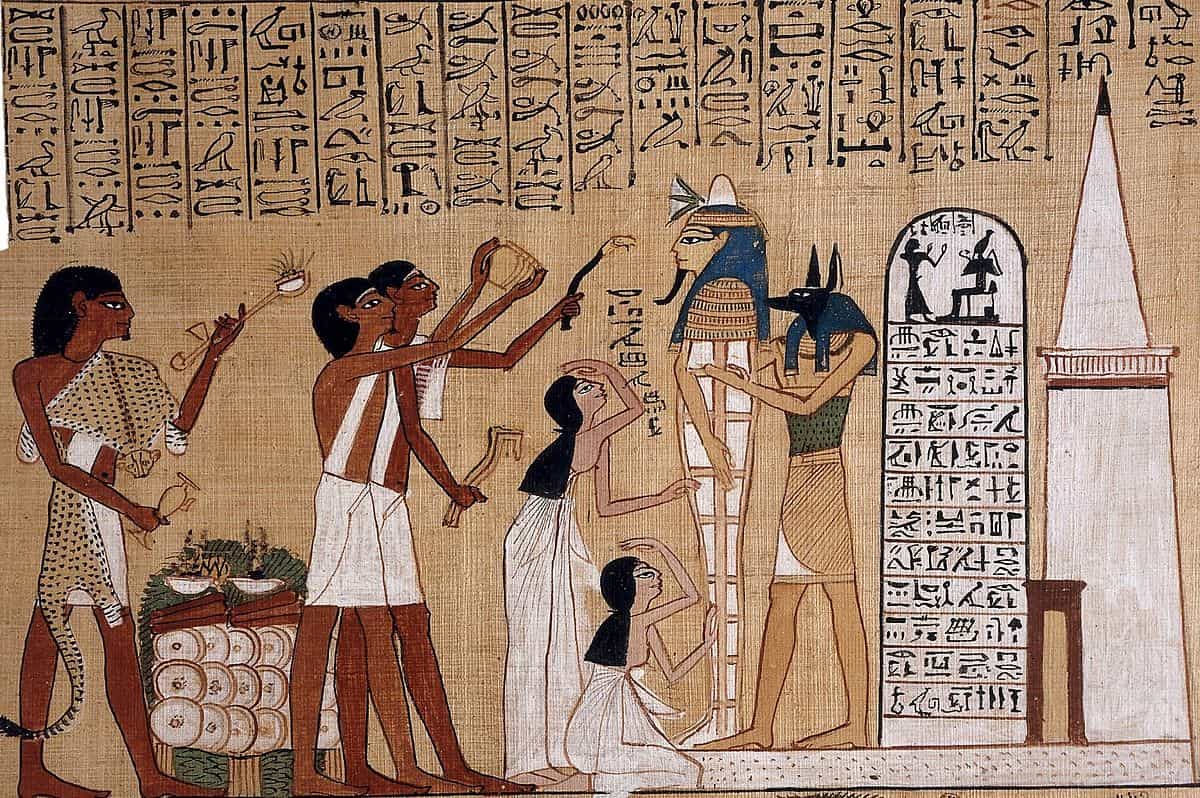Egyptian religion in funerary rituals, In ancient Egypt, death was considered a pivotal moment for the deceased’s journey into the afterlife. The elaborate funeral rituals, including mummification, funerary rites, tomb construction, and the provision of grave tools, were all designed to ensure a successful and prosperous passage to eternity. These practices reflected the Egyptians’ deep-rooted belief in the continuity of life beyond death and the importance of preserving the body and soul for a harmonious existence in the afterworld.
In this article, we will uncover for you the Egyptian religion in funerary rituals. with Top Ten Egypt
The ancient Egyptians would take the dead body (after it had been mummified) in a procession until it reached the eastern shore of the Nile, where a small fleet of boats would wait for them. The main boat had a large room lined from the inside with fabrics. In this room, the dead body was placed, along with statues of: Isis and Nephthys, the two protective goddesses. For the dead, the priest burns incense, and the mourning women continue to slap their heads.
Judgment in the Hall of Ma’at:
- Central to the afterlife beliefs was the concept of judgment in the Hall of Ma’at. According to Egyptian mythology, the deceased would undergo a ritual known as the “Weighing of the Heart” ceremony.
- In this ceremony, the heart of the deceased was weighed against the feather of Ma’at, the goddess of truth and justice. If the heart was lighter than the feather, the soul was deemed pure, and the deceased could proceed to the blissful afterlife. If the heart was heavy with wrongdoing, it risked being devoured by the monstrous deity Ammit, leading to a less favorable fate.
Funeral practices, including elaborate burials, mummification, and the provision of grave goods, were all considered essential for a smooth transition to the afterlife.
Tomb construction was equally crucial. Pyramids, tombs, and mastabas were carefully aligned to celestial bodies, emphasizing the connection between the earthly and divine realms.
Tomb paintings, inscriptions, and artifacts from ancient Egypt serve as invaluable windows into the intricate tapestry of funeral traditions, shedding light on the beliefs, practices, and societal norms of this ancient civilization. These sources play a crucial role in unraveling the mysteries of the afterlife and the journey of the soul, providing historians, archaeologists, and modern enthusiasts with a nuanced understanding of ancient Egyptian funeral traditions.
Egyptian religion in funerary rituals : Here’s why these elements are of paramount importance:
1. Preservation of Religious Beliefs:
· Tomb paintings often depict scenes of religious rituals, funerary rites, and the deceased’s journey to the afterlife. These intricate artworks serve as visual narratives, preserving the religious beliefs and mythological stories that guided the ancient Egyptians in their quest for a prosperous afterlife.
2. Guiding the Deceased:
· Inscriptions, commonly found in tombs, include passages from the Book of the Dead and other sacred texts. These texts were intended to guide the deceased through the perilous journey of the underworld, providing spells and incantations to overcome challenges and gain favor in the afterlife.
3. Depiction of Daily Life:
· Tomb paintings offer glimpses into the daily lives of ancient Egyptians. Scenes of agricultural activities, family life, and social gatherings depicted on tomb walls provide context for the deceased’s earthly existence and underline the cultural importance of familial connections in the afterlife.
4. Symbolism and Rituals:
· Artifacts and tomb decorations are rich in symbolism. The choice of colors, the positioning of figures, and the inclusion of specific objects in tomb scenes all carry symbolic meanings related to the journey of the soul and the deceased’s aspirations for eternal life.
· Rituals such as the Opening of the Mouth ceremony, where the deceased’s senses were ritually restored, are vividly portrayed in tomb reliefs, offering insights into the religious practices associated with burial.
5. Identification and Ancestry:
· Inscriptions often include the names, titles, and genealogy of the deceased. This information not only aids in identifying individuals but also provides a glimpse into the social hierarchy, familial relationships, and the significance of one’s lineage in the afterlife.
6. Cultural Evolution:
· Changes in tomb art and inscriptions over different periods reflect the cultural and religious evolution of ancient Egypt. Variations in burial practices, the prominence of certain deities, and shifts in religious beliefs are discernible through the analysis of tombs and their artistic elements.
7. Funerary Artifacts:
· Grave goods and funerary artifacts buried with the deceased offer practical insights into daily life, personal preferences, and the material culture of ancient Egyptians. These items, ranging from jewelry and pottery to tools and amulets, highlight the individuality of the deceased and their perceived needs in the afterlife.
The enduring significance of Egyptian religion in funerary rituals lies in their multifaceted impact on spirituality, culture, art, and historical understanding. As we explore the remnants of this extraordinary civilization, we find ourselves immersed in a legacy that sought not only to honor the departed but also to navigate the mysteries of existence and transcendence across the boundaries of time.
Browse our complete list of Egypt tours Click Here



Comment (0)